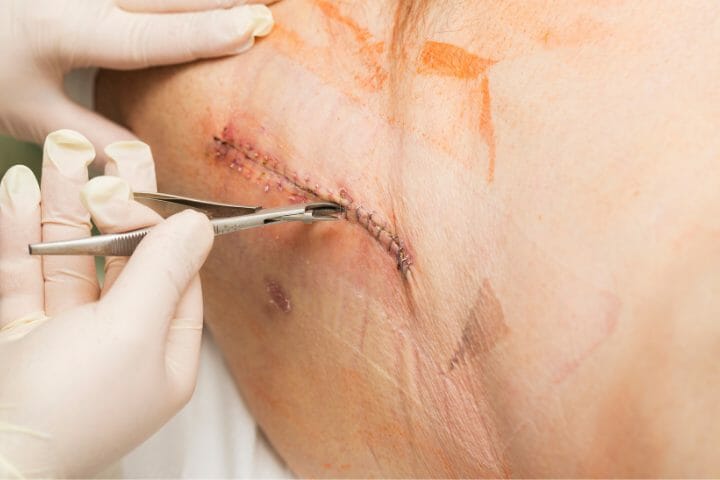Hip replacement can reduce excruciating hip pain. But is it a career ending surgery? Can I play tennis after hip replacement, or does this mean the end of my tennis playing days? Let’s find out.
Contents
Hip replacement is major surgery done to reduce stiffness, poor functioning or chronic pain in your hip. While hip replacement can be a big relief to someone suffering from pain, it does have its downsides.
For example, sports enthusiasts are always confused whether they can play tennis after hip surgery or not? We have mentioned the common issues that arise when you return to the tennis court.
Hip replacement surgery also has some risks associated with it. Let’s glance at the visual guide related to risks and other questions related to hip and knee replacement surgery.

Can You Play Tennis After Hip Replacement or Knee Replacement?
Yes, you can. But only after you make a full recovery.
Tennis is one of the great forms of physical activity as it combines speed, agility, strength and perseverence. Many people who love playing tennis continue playing it throughout their lifetime.
Playing tennis regularly has several advantages, including high flexibility, enhanced cardiovascular endurance, and increased strength.
Since tennis players are usually very attached to the activity. you will find that many of them want to return to the tennis court even after having a total hip or knee replacement. The simpe answer to this is that you need to take time off to make a complete recovery, and then follow the guidelines we have mentioned in the sections below.
You might like to read: Hip Replacement – The Complete Guide For Caregivers And Seniors
Common Issues You Should Consider As You Plan Your Return To The Tennis Court
1. Perfer Clay Courts
You can play on a clay surface court post total joint replacement. The surface is recommended as it is lower and softer than the hard coats. It enhances underfoot comfort and prevents injuries during gameplay. The clay courts influence less upon your joints which reduces the load and provides you some additional time to get ready for the strokes.
2. Take Adequate Warm Up
You need to warm up adequately before starting the gameplay. Warm-up enhances your heart and breathing rate, preparing you for playing the game. Dynamic warm-up can be best for you, including skipping, jogging, different agility moments, and dynamic stretching.

3. Prefer Doubles Over Singles
It is suggested to play doubles instead of singles as you have to occupy only a smaller court area. This won’t exert pressure upon you and your replaced knee and joint. You can gradually increase stress upon the new joint by slowly getting habituated to playing.
4. Practice For A Few Days, Regain Your Strength And Balance
Don’t immediately start participating in competitions with your new knee or hip. It is suggested to learn with the teaching professional to rebuild stamina and take all the vital precautions.
5. Talk To A Physio Before Resuming
You can talk with a physical therapist that you want to play tennis for the first time or resume playing tennis again. You need enough energy, strength, balance, movement, awareness, and flexibility to play the sport adequately.
Your physical therapist will understand your requirements and help you implement all the essential strategies. They will help you know tennis movements specifically, which you can perform adequately.

When Can I Get Back To Playing Tennis After My Knee Or Hip Replacement?
Many orthopedic surgeons recommend playing tennis only once you have fully recovered, provided you are willing to take all the necessary precautions.
Dr. Savyasachi Thakkar, orthopaedic surgeon from Johns Hopkins mentions that this might take anywhere between two to four weeks. Try to follow the suggestions of your surgeon and physical therapist for a certain period until you recover completely.
Hip Replacement Surgery Can Now Be Performed In One Day
Long back, patients had to wait in the hospital for several weeks before they could be sent home. However, now knee and hip replacements can be performed on the same day.
The same-day surgeries are also referred to as outpatient surgery when a patient returns home from the hospital the same day after the surgery. Being at home and taking care of your hip lets you heal quicker and faster and plan your return to the court.
You might like to read: How Long Do You Have To Use A Raised Toilet Seat After A Hip Replacement?
Activities and Sports You Can Do After Hip Replacement
All doctors recommend that low-impact sports can be performed post-hip replacement. Activities and sports like ballroom dancing, bowling, swimming, walking, horseback riding, and low impact sports can be performed after hip replacement for hip dysplasia.

Can you snow ski after hip replacement?
It is essential to understand that you need time to recover from a hip replacement completely. Don’t try to snow ski for at least six months after the surgery. After that, you can snow ski with all the necessary precautions.
Can you do squats after hip replacement?
Squatting can be risky after the hip replacement. However, you can do it safely. Ensure that you do not perform squats after two months of hip replacement and that your physical therapist and surgeon both allow you to perform squats.
Can you lift weights after hip replacement?
Yes, the patients can lift weights to enhance the life of artificial joints.
Can you play sports after hip replacement?
Yes, various patients start participating in sports activities after the hip replacement. However, it is always recommended to participate in low-impact sports to avoid injuries. It is essential to pay attention to the period so as not to overdo any form of exercise or sports.

Can you run marathons after hip replacement surgery?
Yes, you can run on the total hip replacement surgery, but it is always recommended to avoid high-impact activities as it can increase the risks of fractures and injury.
You might like to read: When Can I Sit On A Normal Chair After Hip Replacement
What Are The Risks Associated With Hip Replacement Surgery?
Fracture
Sometimes, certain portions of the hip joint may fracture during surgery. Certain minor fractures can heal on their own. However, severe fractures may need to be treated with the help of metal plates, bone grafts, wires, or screws.
Blood clots
You may notice clots in the veins of the legs post-surgery. This can be problematic because if the clots break off, they will reach the brain, lungs, and heart. With the help of blood-thinning medications, you can overcome this risk.
Dislocations
Doctors always suggest avoiding certain positions because the joint ball may release out of the socket. If you suffer from hip dislocation, you can fix it with the help of a brace; however, if the difficulty continues, then a hip surgery may be required.

Nerve damage causing numbness
Sometimes, the nerves of the area where the implant is done can be injured or physically damaged. It can result in excruciating pain, tiredness and numbness.
Different leg sizes
Surgeons take measures to avoid this problem. The slight variation in the size of the legs isn’t noticeable after a few months of surgery. However, a new hip may result in changes in the size of the legs. This may happen due to the contracture of muscles present across the hip. If you want to overcome it, you need to strengthen and stretch those muscles gradually.
Loosening
This complication is not common after new implants. However, the new joint may not be stabilized adequately or may lose after a certain period, resulting in discomfort. You can overcome this problem with the help of surgery.
Infection
The person may develop an infection at the place of incision or in the inner tissues of the new hip. The person can overcome infection with the help of antibiotics, but due to a severe infection, you may need to get rid of artificial parts with the help of surgery.
You might like to read: How to Use One Crutch After Hip Replacement
What Activities Are Prohibited After Hip Replacement?
You need to avoid these activities post hip replacement.
- Don’t bend you knee higher than your hip.
- Don’t bend forward when you are sitting.
- Don’t sit with your legs crossed for at least 1.5-2 months after surgery.
- Don’t lean forward to pick up something from the ground in a seated position.
- Don’t bend to pull anything like a pillow or blanket while sleeping.

Can You Have a Normal Life After Hip Replacement?
After around 12 weeks of the surgery, things will turn back to normal, and the pain doesn’t last after that for most people. You need to look out for the symptoms of problems and be careful with how you perform your daily activities. After 6 to 12 months, you will recover fully.
Can I Have Both Hips Replaced at the Same Time?
Patients who are less than 75 years old and don’t suffer from cardiopulmonary issues can get both hips replaced simultaneously. However, it can be good if both surgeries are done at different stages.
Frequently Asked Questions
1. After how much time can I play tennis once I have my hip replacement surgery?
After the hip replacement surgery, it is always recommended by the physical therapist and the orthopedic surgeon to rest for around 3 to 6 months until you’re entirely recovered before playing any high-impact sports like tennis.
2. What sports can you do after a hip replacement?
Different physical therapists have different suggestions; however, it is safe for patients to participate in low-impact sports after getting a total hip replacement. They can include sports like double tennis, hiking, cycling, rowing, golf, low impact aerobics, and swimming.
3. Are there permanent restrictions after hip replacement?
You need to take all the necessary precautions for around three months. You need to avoid crossing your legs and follow the necessary instructions given by the
4. Which tennis player had a hip replacement?
Andy Murray has had two hip surgeries. One was in 2018, when he had arthroscopic hip surgery. He missed the Australian, French and Wimbledon opens that year but made a comeback in the US open. He then had a second one in 2019.
A Few Final Words
Hip replacement becomes an absolute necessity when the complications increase due to old age. Many sports enthusiasts are always confused about whether they can play tennis after the surgery or not.
Low impact exercises are often recommended, so playing tennis doubles is suitable for post-surgery patients. We have also mentioned risks associated with hip and knee replacement surgery. Your review is always essential for us to improve further. We thank you for reading up to this point, and if you have any doubts, please do not hesitate to reach out to us.
